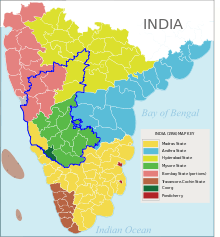Mysore State
| Mysore State | |||||
| State of India | |||||
| |||||
.svg.png) | |||||
| History | |||||
| • | Accession of the Kingdom of Mysore to the Indian Union | 09 August 1947 | |||
| • | Renamed Karnataka State | 1 November 1973 | |||
Mysore State was a separate state within the Union of India from 1948 until 1956[1] with Mysore as its capital. The state was considerably enlarged in 1956 when it became a linguistically homogeneous Kannada-speaking state in 1956, within the Union of India. It was subsequently incorporated into the state of Karnataka.
History
The Kingdom of Mysore /maɪˈsɔər/ was one of the three largest princely states within the former British Empire of India. Upon India gaining its independence in 1947, the Maharaja of Mysore signed the instrument of accession incorporating his realm with the Union of India on 15 August 1947. The territories of the erstwhile princely state of Mysore were then reconstituted into a state within the Union of India.[2]

In 1956, the Government of India effected a comprehensive re-organisation of provincial boundaries, based upon the principle of shared language. As a result of the States Reorganisation Act on 1 November 1956, the Kannada-speaking districts of Belgaum (except Chandgad taluk), Bijapur, Dharwar, and North Canara were transferred from Bombay State to Mysore State.[3] Bellary district was transferred from Andhra State. South Canara and Udupi districts were transferred from Madras State and the Koppal, Raichur, Gulbarga and Bidar districts from Hyderabad State. Also small Coorg State was merged, becoming a district of Mysore State.[4][5]
Rajpramukh
- 1947 - 1 Nov 1956 Jayachamarajendra Wodeyar (b. 1919 - d. 1974)

Governors
- 1 Nov 1956 - 4 May 1964 Jayachamarajendra Wodeyar (s.a.)
- 4 May 1964 - 2 Apr 1965 Satyavant Mallannah Srinagesh (b. 1903 - d. 1977)
- 2 Apr 1965 - 13 May 1967 Vaharagiri Venkata Giri (b. 1894 - d. 1980)
- 13 May 1967 - 30 Aug 1969 Gopal Swarup Pathak (b. 1896 - d. 1982)
- 30 Aug 1969 - 22 Oct 1969 A.R. Somnath Iyer
- 23 Oct 1969 - 1 Feb 1972 Dharma Vira (b. 1906 - d. 2000)
- 1 Feb 1972 - 10 Jan 1976 Mohan Lal Sukhadia (b. 1916 - d. 1982)
Chief ministers
- 1946 - 25 Oct 1947 Arcot Ramaswami Mudaliar (b. 1887 - d. 1976)
- 25 Oct 1947 - 30 Mar 1952 Kysasambally Chengalaraya Reddy (b. 1902 - d. 1976) INC
- 30 Mar 1952 - 19 Aug 1956 Kengal Hanumanthaiah (b. 1908 - d. 1980) INC
- 19 Aug 1956 - 1 Nov 1956 Kadidal Manjappa (b. 1910 - d. 1992) INC
- 1 Nov 1956 - 16 May 1958 Siddhavvanahalli Nijalingappa (b. 1902 - d. 2000) INC (1st time)
- 16 May 1958 - 9 Mar 1962 Basappa Danappa Jatti (b. 1912 - d. 2002) INC
- 9 Mar 1962 - 14 Mar 1964 President's rule
- 14 Mar 1962 - 21 Jun 1962 Shivalingappa Rudrappa Kanthi INC
- 21 Jun 1962 - 3 Mar 1967 Siddhavvanahalli Nijalingappa (s.a.) INC (2nd time)
- 3 Mar 1967 - 29 May 1968 President's rule
- 29 May 1968 - 27 Mar 1971 Veerendra Patil (1st time) (b. 1924 - d. 1997) INC
- 27 Mar 1971 - 20 Mar 1972 President's rule
- 20 Mar 1972 - 31 Dec 1977 Devaraj Arasu (b. 1915 - d. 1982) INC
See also
References
- ↑ "States of India since 1947". World Statesman. Archived from the original on 1 July 2014. Retrieved 9 July 2014.
- ↑ Political and administrative integration of princely states By S. N. Sadasivan.
- ↑ "States Reorganization Act 1956". Commonwealth Legal Information Institute. Retrieved 1 July 2008.
- ↑ Development of Mysore state, 1940-56 by M. B. Gayathri
- ↑ Karnataka government and politics By Harish Ramaswamy, S. S. Patagundi, Shankaragouda Hanamantagouda Patil
Coordinates: 12°18′N 76°39′E / 12.30°N 76.65°E